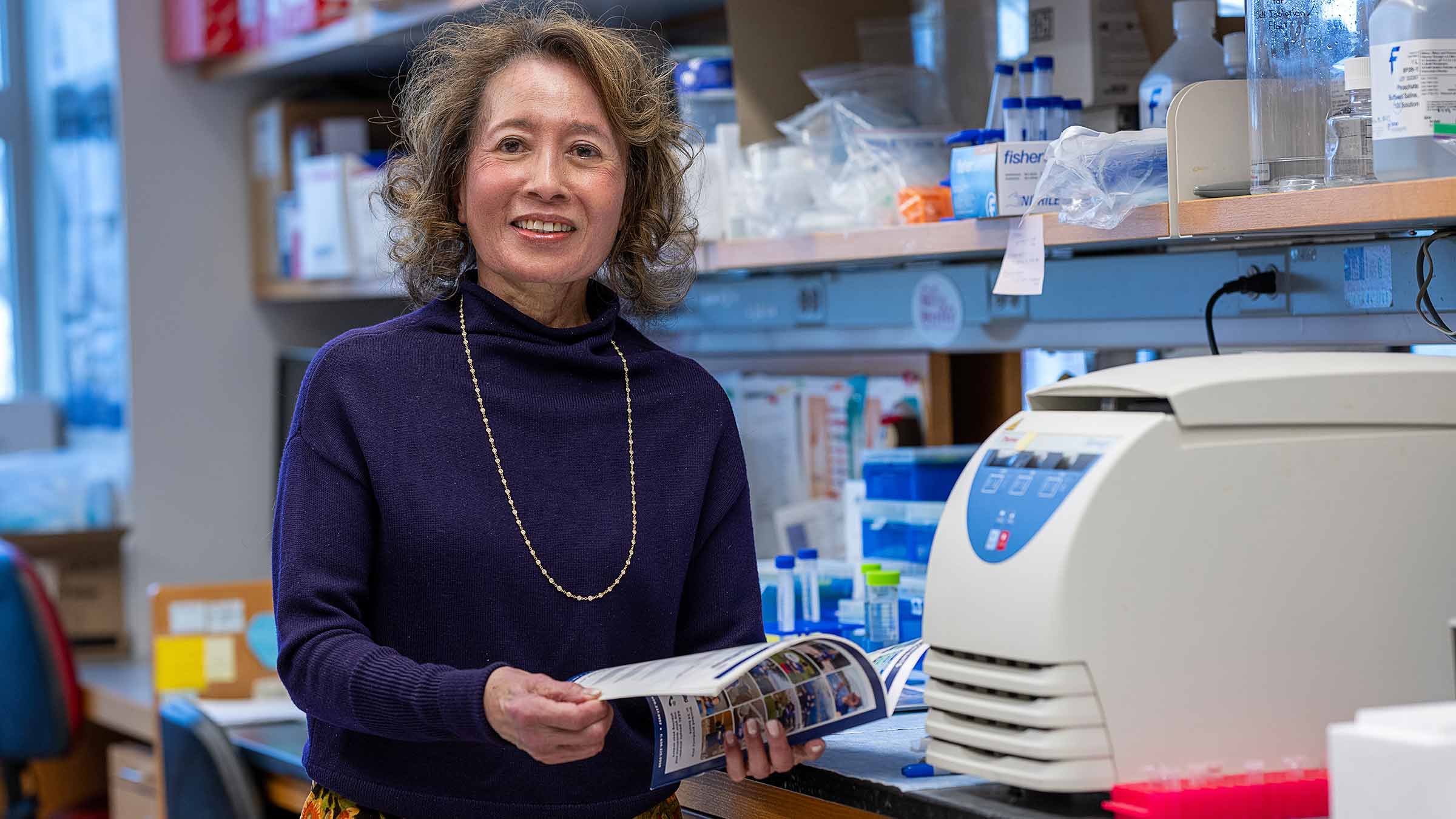From kitchen to clinic: Research projects explore ways to stop diabetes
Ohio State researchers are using creative approaches to fight the diabetes epidemic.
The burners are lit, and the cod is sizzling.
This fish taco bowl recipe calls for cauliflower cut into tiny pieces instead of rice; spices stand in for sour cream. Low in carbs and salt. High in fiber. But no one complains.
“Look at this fish,” Melanie Wilson says about what she and her classmate just prepared: cod sautéed in a drizzle of olive oil, topped with herbs.
“I never would have thought to make it that way.”
At home, Wilson says, she probably would have coated it in breadcrumbs, fried it in butter.
She’s learning healthy food doesn’t have to be bland. By the end of the two-hour class on the east side of Columbus, Wilson and the dozen others in class will not only have cooked and eaten fish taco bowls, but they’ll take home a bag with all the ingredients to make it again at home.
“These are gourmet meals,” Wilson says. “You really need to get the chicken fajita recipe from last week.”

Research to lower blood sugar
Everyone in Wilson’s class has type 2 diabetes. The “Cooking Matters for Diabetes” class is part of a study that also provides them free groceries to prepare a meal, diabetes education, a referral to a food pantry and meetings with a community health worker who can help them get other essentials, such as a job or transportation. The aim is to bring down their blood glucose levels.
Physicians and researchers with The Ohio State University Wexner Medical Center Diabetes and Metabolism Research Center are running the study, one of about 30 the center is involved in. As more and more people are diagnosed with diabetes or prediabetes, the center’s researchers hope to prevent the disease and its complications: heart disease, strokes, blindness, kidney failure and amputation.
Among the center’s current studies is one that tests whether glucose levels improve for pregnant women with type 2 diabetes when they’re given continuous glucose monitors. Other research examines how a high-fat diet can trigger a cascade of problems in your gut and cause chronic inflammation throughout your body.

“We have to stop this horrible epidemic. Diabetes targets nearly every organ in the body.”Willa Hsueh, MD, director of The Ohio State Diabetes and Metabolism Research Center and professor of Internal Medicine at The Ohio State University College of Medicine.
How diabetes affects Ohioans
One in every eight people in Ohio, on average, has been diagnosed with diabetes. That tops the national rate of one in 10. An increase in obesity is fueling the rise in the number of people with either type 2 diabetes or prediabetes.
Most people with diabetes have type 2. Their body doesn't properly use insulin, a hormone that helps control blood sugar levels. Many factors can bring on type 2 diabetes, including being overweight, not being physically active and having an unhealthy diet.
A much smaller number of people have type 1 diabetes. Their bodies produce little to no insulin, causing high blood sugar levels. An autoimmune disorder causes type 1 diabetes by destroying the cells that make insulin.
“We know that people living with uncontrolled diabetes may not live as long.”Joshua Joseph, MD, MPH, an endocrinologist and associate professor of Endocrinology, Diabetes and Metabolism at the Ohio State College of Medicine.
Though researchers have yet to figure out how to prevent type 1 diabetes, type 2 diabetes can be avoided, delayed or even cured with healthy eating, exercise and weight loss.

People at highest risk of diabetes
Nationally, people of color have the highest rates of diabetes. The Ohio State Wexner Medical Center is hoping to change that.
Health screenings, as well as classes in exercise, cooking, and diabetes prevention and control are all now offered for free at the Healthy Community Center on the east side of Columbus, which The Ohio State Wexner Medical Center runs. Twice a month, an online diabetes-friendly cooking demonstration is offered to anyone who signs up.
“People are very receptive,” says Dr. Joseph, medical director of the Healthy Community Center. “We all want to lead long, healthy lives.”
Reducing risks of glucose spikes
Back in the kitchen, the topic is carbs. The goal is to have carbs take up only about one-third of a meal. Another third, veggies, and one-third protein.
“There are no bad foods. There are good choices, and there are better choices.”Jenny Shrodes, RD, CDCES, a dietitian and diabetes care and education specialist for the Ohio State Wexner Medical Center who co-teaches the Cooking Matters for Diabetes class.
White bread vs. wheat bread. Apple juice vs. an apple.
“If you want a piece of chocolate cake, have a piece of chocolate cake,” Shrodes says.
“Not the whole cake,” a woman says.
Shrodes and others laugh. “That’s right. Not the whole cake.”
A few bites into her fish taco bowl, Wilson, 47, checks her continuous glucose monitor, just out of curiosity. Her blood sugar is only up a couple of points, which surprises her.
Having just gotten the monitor recently, she’s finding out the kinds of foods that cause her blood sugar to spike.
“I want to learn to fuel my body better,” she says.

Protecting the next generation
Diabetes in pregnancy can be risky for the mother as well as the infant.
In one medical center study, low-income pregnant central Ohio women with uncontrolled type 2 diabetes are given a continuous glucose monitor, a mobile app and more access to their health care provider team through a virtual dashboard. They also get help with needs such as food, housing and childcare.
Researchers hope that with the additional support the pregnant women receive in the study, the women will help avoid peaks and dips in their glucose levels and give birth to healthy babies.
“If you’re uninsured or Medicaid‐insured and you have unmet social needs, poor glucose control and now you’re pregnant, how are you going to get your glucose levels under control?’’ says Kartik Venkatesh, MD, PhD, a maternal fetal medicine specialist, who co-leads the study with Dr. Joseph and Naleef Fareed, PhD, MBA, an associate professor in the Department of Biomedical Informatics at the Ohio State College of Medicine.
Another study, the largest ever testing treatments for gestational diabetes, will compare insulin and Metformin, a medication to control blood glucose levels, to see if they’re both equally safe and effective.
“This is truly a once-in-a-lifetime opportunity for our patients and providers to shape the future of gestational diabetes care,” says Dr. Venkatesh, who co-leads that study with Mark Landon, MD, professor and chair of the Department of Obstetrics and Gynecology at the Ohio State College of Medicine.

How research brings us closer to a cure
A cure for diabetes is not out of reach. Researchers at Ohio State are interested in the potential of replacing insulin-making cells in people with type 1 diabetes so they can produce their own insulin again.
Type 1 diabetes destroys insulin-producing beta cells in the pancreas. Taking healthy beta cells from a donor and putting them into someone with diabetes has shown promising results, says Kathleen Wyne, MD, PhD, an endocrinologist and clinical professor of Internal Medicine at the Ohio State College of Medicine.
Beta cell research also can help people with type 2 diabetes who may lose insulin-producing beta cells because of high blood glucose levels, age and other factors.
The challenge in curing diabetes is that so many body functions are involved in turning food into glucose and making that glucose available to cells for energy, Dr. Wyne says.
“There’s not one single key gene that you can turn on or off to eliminate diabetes,” she says about both type 1 and type 2 diabetes.
“But if we can figure out what triggers the immune system to attack the beta cells, then we can figure out how to stop it.”






